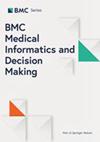DEL-Thyroid: deep ensemble learning framework for detection of thyroid cancer progression through genomic mutation
IF 3.3
3区 医学
Q2 MEDICAL INFORMATICS
引用次数: 0
Abstract
Genes, expressed as sequences of nucleotides, are susceptible to mutations, some of which can lead to cancer. Machine learning and deep learning methods have emerged as vital tools in identifying mutations associated with cancer. Thyroid cancer ranks as the 5th most prevalent cancer in the USA, with thousands diagnosed annually. This paper presents an ensemble learning model leveraging deep learning techniques such as Long Short-Term Memory (LSTM), Gated Recurrent Units (GRUs), and Bi-directional LSTM (Bi-LSTM) to detect thyroid cancer mutations early. The model is trained on a dataset sourced from asia.ensembl.org and IntOGen.org, consisting of 633 samples with 969 mutations across 41 genes, collected from individuals of various demographics. Feature extraction encompasses techniques including Hahn moments, central moments, raw moments, and various matrix-based methods. Evaluation employs three testing methods: self-consistency test (SCT), independent set test (IST), and 10-fold cross-validation test (10-FCVT). The proposed ensemble learning model demonstrates promising performance, achieving 96% accuracy in the independent set test (IST). Statistical measures such as training accuracy, testing accuracy, recall, sensitivity, specificity, Mathew's Correlation Coefficient (MCC), loss, training accuracy, F1 Score, and Cohen's kappa are utilized for comprehensive evaluation.DEL-甲状腺:通过基因组突变检测甲状腺癌进展的深度集合学习框架
基因以核苷酸序列的形式表达,容易发生突变,其中一些突变可导致癌症。机器学习和深度学习方法已成为识别癌症相关突变的重要工具。甲状腺癌是美国第五大高发癌症,每年有数千人确诊。本文介绍了一种利用长短期记忆(LSTM)、门控递归单元(GRU)和双向 LSTM(Bi-LSTM)等深度学习技术的集合学习模型,用于早期检测甲状腺癌突变。该模型在来自 asia.ensembl.org 和 IntOGen.org 的数据集上进行了训练,该数据集由 633 个样本组成,涉及 41 个基因的 969 个突变,这些样本收集自不同人口统计学特征的个体。特征提取技术包括哈恩矩、中心矩、原始矩和各种基于矩阵的方法。评估采用了三种测试方法:自一致性测试(SCT)、独立集测试(IST)和 10 倍交叉验证测试(10-FCVT)。所提出的集合学习模型表现出良好的性能,在独立集测试(IST)中达到了 96% 的准确率。在综合评估中采用了训练准确率、测试准确率、召回率、灵敏度、特异性、马休相关系数(MCC)、损失、训练准确率、F1 分数和科恩卡帕等统计指标。
本文章由计算机程序翻译,如有差异,请以英文原文为准。
求助全文
约1分钟内获得全文
求助全文
来源期刊
CiteScore
7.20
自引率
5.70%
发文量
297
审稿时长
1 months
期刊介绍:
BMC Medical Informatics and Decision Making is an open access journal publishing original peer-reviewed research articles in relation to the design, development, implementation, use, and evaluation of health information technologies and decision-making for human health.

 求助内容:
求助内容: 应助结果提醒方式:
应助结果提醒方式:


